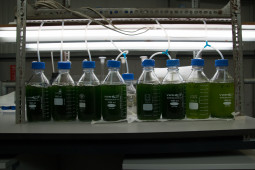Microalgae for Nutrient Removal
The European Commission has today adopted proposals to turn Europe into a more circular economy and boost recycling of liquid and solid wastes. In EU countries, a lot of reverse osmosis (RO) treatment systems were designed for the treatment of urban wastewaters, leachates from sanitary landfills and several other kind of liquid wastes. Disposal of concentrate is a key factor to be addressed, and normally the concentrate is rich in several nutrients, such as phosphorous and nitrogen. Microalgae are seen as a very promising flexible feedstock, being considered the crop of the future. They grow fast, just needing sunlight, carbon dioxide and minerals. Presently, our main research lines are focused on the use of wastewaters (concentrates from RO systems; pre-treated leachates) as a culture medium of microalgae reducing the requirements in water and nutrients. Wastewater treatment using the microalgae has several advantages over conventional treatments: i) nitrogen and phosphorous can be converted into biomass without the addition of carbon source; ii) the discharged effluent into water bodies is oxygenated and obeys the discharge limits imposed by legislation; iii) high value products can be extracted from microbial biomass. One of your main goals is the use of photobioreactors with compound parabolic collectors, being able to maximize the capture of UV photons, favoring the production of microalgae rich in high value products.

S.F.L. Pereira, A.L. Gonçalves, F.C. Moreira, T.F.C.V. Silva, V.J.P. Vilar, J.C.M. Pires. Nitrogen removal from landfill leachate by microalgae. International Journal of Molecular Sciences, 17, 1926, 1-14, 2016
N.F.P. Silva, A.L. Gonçalves, F.C. Moreira, T.F.C.V. Silva, F.G. Martins, M.C.M. Alvim-Ferraz, R.A.R. Boaventura, V.J.P. Vilar, J.C.M. Pires. Towards sustainable microalgal biomass production by phycoremediation of a synthetic wastewater: A kinetic study. Algal Research, 11, 350-358, 2015




